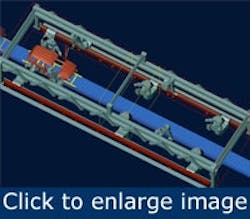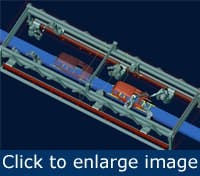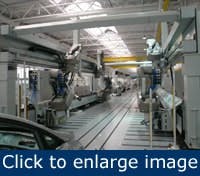Compact, fully-automated painting lines
Can you imagine a fully-automated painting line, with nearly 30% reduction in length compared to traditional processes, highly flexible and with capacity of more than 50 units per hour? A dream? No, it’s reality. Such a line already is in operation and combines an automation concept with an integrated application process.
Short booth lengths save money, first in capital cost and then on operating costs. Cost is one of the most important considerations when planning for a new paint shop. The most dramatic factor in booth length is a compact painting process that features a solvent-based, three-wet process along with a fully automated exterior and interior robotic application process. Its advantages include low costs per unit achieved through high transfer efficiency, low color change losses, reduced energy consumption, and related carbon dioxide emissions. Customers benefit from the particularly consistent film uniformity and high quality level finishes.
Process stability also is an important consideration. Contemporary painting robots have high uptimes, but what happens if a failure occurs? The simplest and most frequently practiced response is the manual backup zone. Manual operators, however, come with some disadvantages including additional booth length, quality problems resulting from the sensitivity of modern paint materials, narrow process windows, and limited painter experience.
Traditionally, adding booth length and application equipment avoids these pitfalls. Another way to compensate for robot downtime is to reassign the painting scopes in the affected station to the remaining robots. This degrade concept might cause a temporary reduction in system throughput and can be managed with the number of robots required for normal production. If temporary production loss isn’t allowed, redundancy must be part of the robot station design.
Figure 1. A comparison of two concepts for a solvent-based, three-wet process. The capacity in both lines is 50 units per hour. Waterborne lines can achieve similar reductions, but have longer flash zones.
Figure 2. The degrade concept is normal for the exterior application, eliminating backup zones. In the more complex interior painting, not only painting robots are used, but also handling robots for doors and hoods that must be opened and closed. In standard interior painting concepts with only one traveling rail per side, handling robots share the rail with the painting robots. “Overtaking” is not possible, limiting flexibility.
Figure 3. The painting robots on the lower rail and the handling robots on the upper one can act independently. Overtaking is now possible. A further point is that hood openers also can open doors and a painting robot can replace handling robots. This reduces overall station length.
Figure 4. This achieves degrade and eliminates backup zones. These illustrations show various operational modes.
Figure 5. Painting robots and handling devices are arranged above each other to save space. Combining the interior and exterior application during degrade mode further optimizes robot count and increases efficiency. The robot must be able to paint interiors and exteriors and be able to open doors and hoods. The exterior station could be laid out optimally without redundancy having an atomizer that can be used equally well for interior and exterior surfaces and that features a narrow and wide paint pattern with high transfer efficiency and high paint appearance quality.
Figure 7. The EcoBell2 HX is based on the industry leading EcoBell2 for exterior painting and now designed also for interior applications as well as fascias and trim pieces, where large surfaces, narrow areas and sharp edges are combined, often with an extremely complex geometry, both with HV and without. The EcoBell2 HX atomizer is equally suitable for interior and exterior applications as well as for plastic trim pieces.
It’s no longer necessary to have different applicators for different painting zones. Processes can be optimized. Modular or integrated concepts in which a vehicle can be painted completely in a fully automated manner in one station are within reach. This means much better cycle utilization, lower paint losses during color change, as well as high system flexibility. It’s possible to react to market demands considerably better by switching individual modules on or off.







